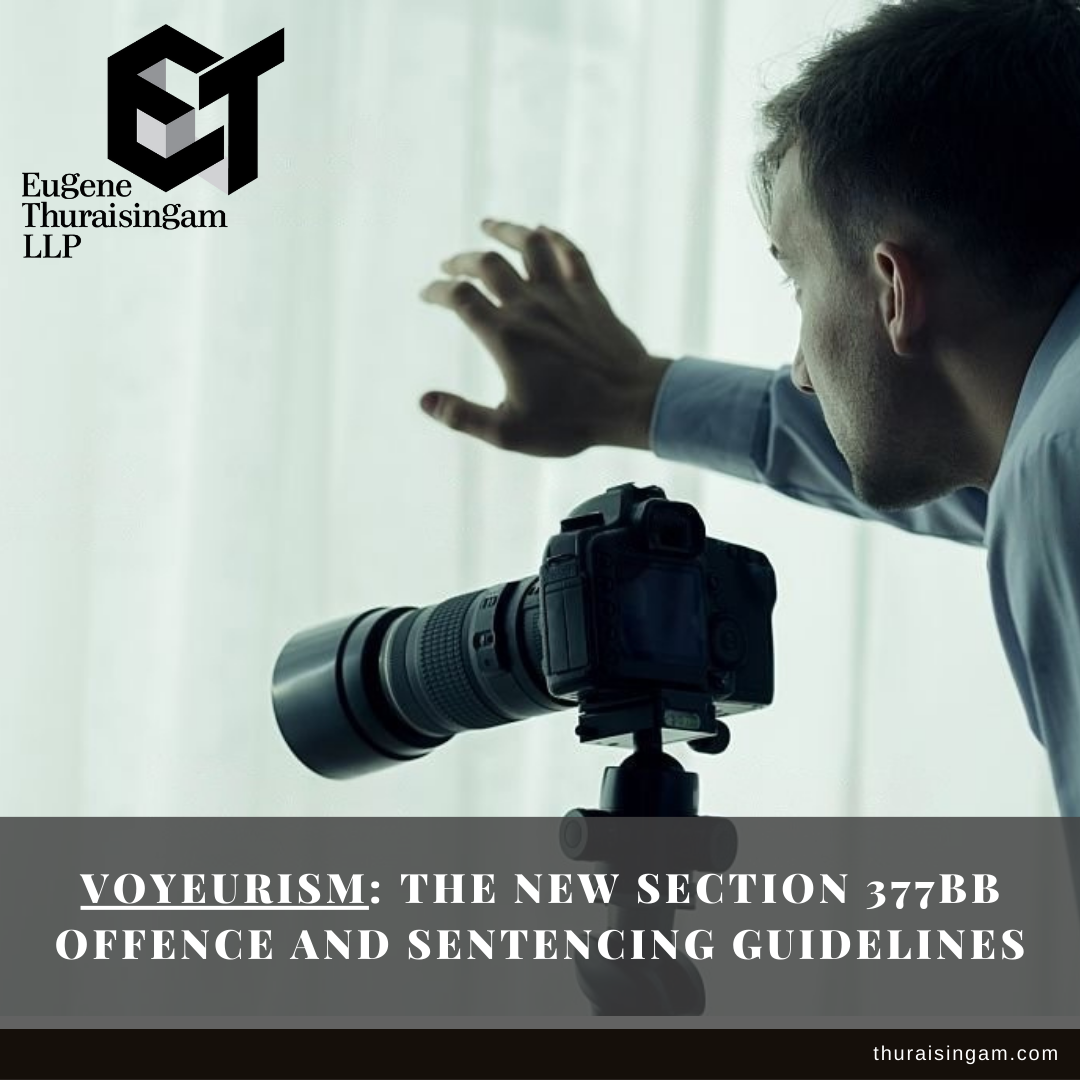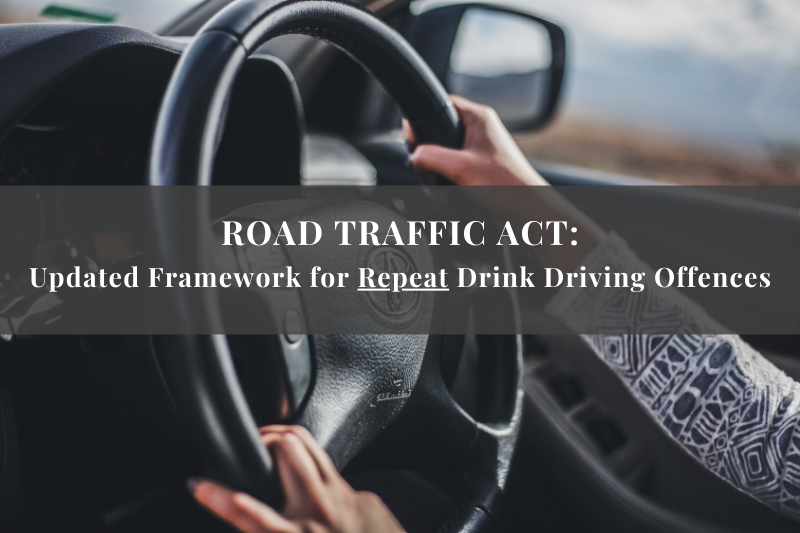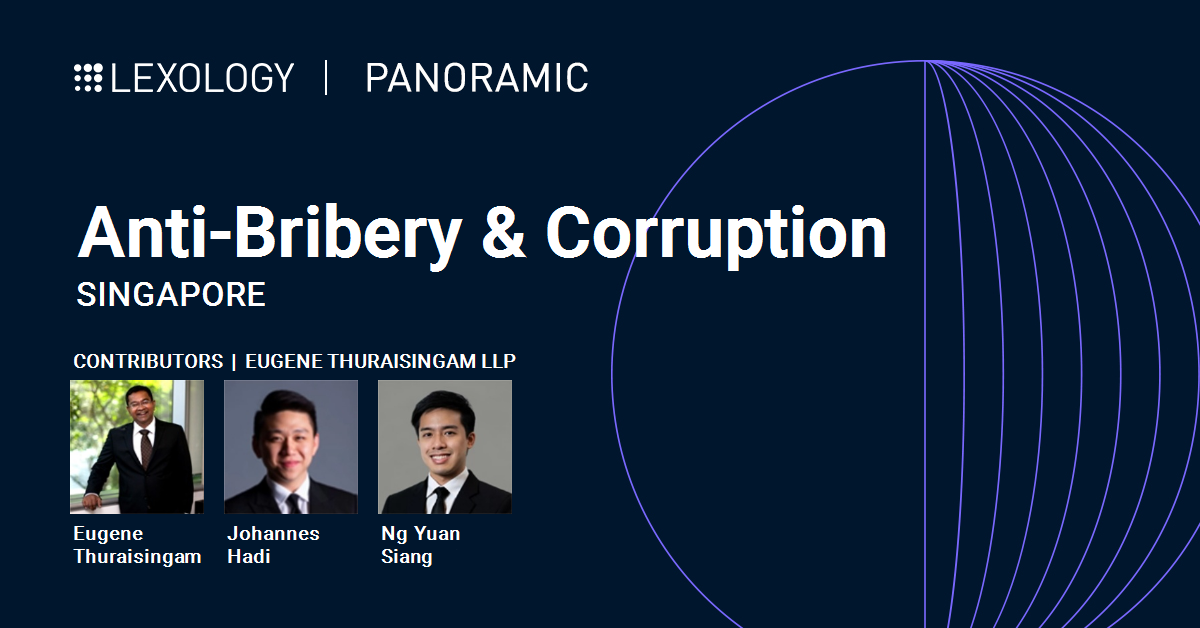Voyeurism: The new Section 377BB Offence and Sentencing Guidelines
What is Voyeurism?
“Voyeurism” refers to the observation or recording of someone doing a private act without the person’s consent. [1] Some more commonly known types of voyeurism include “up-skirting” and “down-blousing”.
Pre-2020, voyeurism was not criminalised under any specific statutory provision. Instead, the courts relied on a patchwork of laws, including insult of modesty under the now-repealed Section 509 of the Penal Code, making or reproducing obscene films under Section 29 of the Films Act, and possession of obscene films under Section 30 of the Films Act, to punish voyeurs. This patchwork of laws, however, did not adequately cover the range of circumstances in which voyeurism offences are committed. For instance, the possession of voyeuristic still images (ie not films or videos).
Another problem was how the now-repealed Section 509 of the Penal Code only criminalised acts done to insult a woman’s modesty, but not a man’s modesty. This created an anomaly in the way offenders were prosecuted and sentenced. In Public Prosecutor v Colin Teo Han Jern [2017] SGMC 74 which involved charges under the Films Act for unlawful recordings of men engaging in sexual acts, the District Court observed that only Parliament could resolve the question of whether a man’s modesty could be insulted. [2] On this basis, the court declined to use sentencing benchmarks in relation to an offence under the now-repealed s 509 of the Penal Code to guide the imposition of the sentences it eventually meted out although the wrongdoing committed was similar. [3]
Against this backdrop, the Criminal Law Reform Act 2019 introduced Section 377BB of the Penal Code which defined the offending behaviour of voyeurism and provided adequate punishments. [4] For instance, “upskirting” was previously punishable under the now-repealed section 509 of the Penal Code which did not explicitly criminalise the act of recording a video (of women) and had a maximum jail term of one year. Now, the maximum jail term under section 377BB of the Penal Code has been doubled to two years.
Thus, after the most recent raft of amendments to the Penal Code that came into force on 1 January 2020, Voyeurism is now an offence under Section 377BB of the Penal Code. There are six offence-creating provisions in ss 377BB(1)–(6) PC as illustrated in the table below: [5]
Object of voyeuristic conduct
Actus reus | Victim doing a “private act” (as defined in s 377C(f) PC) | Victim’s private regions which “would not otherwise be visible” |
| Observing | s 377BB(1) PC | NIL |
| Operating equipment to observe | s 377BB(2) PC | s 377BB(4) PC |
| Recording | s 377BB(3) PC | s 377BB(5) PC |
| Installing equipment or constructing/adapting structure | s 377BB(6) PC | |
You may be found guilty of an offence under Section s 377BB(1) of the Penal Code if you:
- intentionally observe another person (B) doing a private act without B’s consent; and
- know or have reason to believe that B does not consent to being observed [6]
You may be found guilty of an offence under Section s 377BB(2) or s 377BB(4) of the Penal Code if you:
- operate equipment without another person’s (B) consent with the intention of enabling yourself or another person to observe
- B doing a private act; [7] or
- B’s genital region, breasts (if B is female), or buttocks (whether exposed or covered) in circumstances where they would not otherwise be visible; [8] and
- know or have reason to believe that B does not consent to you operating equipment with that intention.
Under Sections s 377BB(2) and 377BB(4), you will still be found guilty even if B’s private act was not recorded.
You may be found guilty of an offence under Sections 377BB(3) and 377BB(5) of the Penal Code if you:
- intentionally or knowingly record without another person’s (B) consent
- B doing a private act; [9] or
- an image of B’s genital region, breasts if B is female, or buttocks (whether exposed or covered), in circumstances where they would not otherwise be visible; [10] and
- know or have reason to believe that Bdoes not consent to you recording the act or image.
You may be found guilty of an offence under Section 377BB(6) of the Penal Code if you:
- install equipment, or construct or adapt a structure or part of a structure; and
- with the intention of enabling yourself or another person to commit an offence under subsection (1), (2), (3), (4) or (5). [11]
Section 377BB(9) also introduces a rebuttable presumption: If you have recorded another person doing a private act or of their private parts if they would not otherwise be visible, it will be presumed that the person being recorded did not consent to being observed or recorded. As explained by then Minister for Home Affairs, Mr K Shanmugam, this provision is especially meant to address evidential challenges where the person recorded is unable to be identified. In such cases, it is presumed that the person did not give his or her consent to being recorded, and the onus is on the offender to explain why the person had consented. [12]
What are the Penalties for Voyeurism?
If you are convicted of voyeurism, you could get:
- Up to 2 years’ jail;
- a fine;
- caning; or
- any combination of the above punishments. [13]
If the offence is committed against a victim below 14 years of age, the offender will be sentenced to up to 2 years’ jail AND either a fine or caning. [14]
How will the Exact Punishment be Determined for Voyeurism Offences?
In Nicholas Tan Siew Chye v Public Prosecutor [2023] SGHC 35 (“Nicholas Tan”), the General Division of the High Court (“HC”) provided a timely framework for sentencing offenders convicted of voyeurism under Section 377BB(4) of the Penal Code.
The offender in Nicholas Tan pleaded guilty to two charges under Section 377BB(4) of the Penal Code, with one charge of criminal trespass under Section 447 of the Penal Code taken into consideration for the purpose of sentencing. He was initially sentenced to seven weeks’ jail, but this was reduced to three weeks on appeal to the HC.
Rehabilitation and an extremely strong propensity for reform in s 377BB(4) Offences
The HC first considered whether rehabilitation will be the dominant sentencing consideration for voyeurism offences under s 377BB(4) PC committed by adult offenders with no mental condition that contributed to their voyeuristic conduct.
In this regard, the HC held at [42] that deterrence rather than rehabilitation is generally the dominant sentencing consideration for a s 377BB(4) PC offence. As such, sentences imposed for s 377BB(4) PC offences would likely include a jail term. Rehabilitation, while relevant, would only be a subsidiary sentencing consideration which would be given effect to by reducing the overall jail term where appropriate. [15]
However, there may be cases where deterrence may instead by displaced by rehabilitation as the dominant sentencing consideration for the s 377BB(4) PC offence. [16] The list of factors that would result in such a shift are non-exhaustive and would depend on the facts of each case, and include:
- Whether the particular adult offender in question has demonstrated an extremely strong propensity for reform;
- If the offender is a youthful offender (ie, below age 21); or
- The offender has a mental condition that is causally linked to the commission of the offence.
Nevertheless, the Court cautioned that it would rarely be the case that emphasis would shift away from deterrence to rehabilitation, even where the s 377BB(4) PC adult offender has demonstrated an extremely strong propensity for reform; only a truly exceptional case would warrant this. [17]
Sentencing Framework for voyeurism offences
The HC then chose to adopt the two-stage, five-step sentencing framework set out in Logachev Vladislav v Public Prosecutor [2018] 4 SLR 609 (“Logachev”) for voyeurism offences under s 377BB(4) PC. [18]
| Stages | Steps |
| Stage 1: Court arrives at an indicative starting point sentence for the offender upon considering the intrinsic seriousness of the offending act | Step 1: Identify the level of harm caused by the offence and the level of the offender’s culpability |
| Step 2: Identify the applicable indicative sentencing range in a three-by-three matrix by reference to the level of harm caused by the offence (in terms of low, moderate and high) and the level of the offender’s culpability (in terms of low, moderate and high) | |
| Step 3: Identify the appropriate starting point within the indicative starting range having regard to the level of harm caused by the offence and the level of the offender’s culpability | |
| Stage 2: Court adjusts the starting point sentence identified at stage 1 | Step 4: Adjust the starting point sentence having regard to offender-specific aggravating and mitigating factors |
| Step 5: Where an offender has been convicted of multiple charges, make further adjustments, if necessary, to the sentence for the individual charges in the light of the totality principle |
Stage 1 Step 1: Offence-specific factors
At step 1, the court considers two things: the harm caused by a s 377BB(4) PC offence and the level of the offender’s culpability.
As regards the harm caused, the Court categorised harm into three types: [19]
- Invasion of the victim’s privacy, in cases where there was unwanted observation of the victim’s private region, or the retention or dissemination of a record of the victim’s image;
- Violation of the victim’s bodily integrity, in cases where the offender made physical contact with the victim in the course of committing the s 377BB(4) PC offence;
- Humiliation, alarm or distress, in cases where the victim was made aware of the offending conduct.
As regards the first type of harm, actual or potential invasions of privacy may arise in three situations. First, where the offender observes the victim. The more intrusive the observation, the greater the actual loss of privacy [20]. Even if an offender did not observe, record or disseminate recordings of the victim, the intrusiveness of the offender’s intended observation of the victim (eg, whether the offender intended to observe a fully nude or partially dressed victim), and whether the offender intended to record or disseminate a record of the victim’s image, may be relevant in evaluating the offender’s culpability. Of course, all other things being equal, an offender who intended to record the victim (but failed to do so) is more culpable than an offender who merely intended to observe the victim. [21] Second, where the offender retains a record of the victim’s image or disseminates a record of the victim’s image. If the victim is identifiable from the recording, the level of harm caused will be higher. [22] Third, where the offender not only retained a record of the victim’s image but also disseminated it. The extent of the invasion of privacy arising from such dissemination can be evaluated by reference to the factors set out in Public Prosecutor v GED [2022] SGHC 301 (“GED”) at [51]–[53], such as how widely the record was distributed, whether it was distributed to certain recipients known to the victim, and the degree of identifiability of the victim. [23]
As regards the second type of harm, the level of harm will be greater if, for example, you made prolonged physical contact with the victim’s private parts or inflicted violence upon the victim in the course of committing the s 377BB(4) PC offence. [24]
As regards the third type of harm, victims may suffer humiliation, alarm or distress during or subsequent to the offence (e.g post-traumatic stress disorder). The existence and extent of the emotional harm suffered may either be disclosed by the victim or inferred from the circumstances and may need to be corroborated by evidence (including expert evidence). In particular, where it is alleged that the victim had developed conditions such as depression or post-traumatic stress disorder as a result of the offending conduct, such allegations should be supported with evidence in the form of victim impact statements and medical reports. [25]
The factors going towards culpability are: [26]
- (a) whether the offender actually knew, or merely had reason to believe, that the victim had not consented to be observed. An offender who actually knew that the victim did not consent to the offending conduct would have a higher culpability than one who merely had reason to believethat the victim had not consented to the offending conduct [27]
- (b) degree of premeditation and planning;
- (c) stalking or following victim;
- (d) type and sophistication of equipment used and whether it was concealed;
- (e) breach of relationship of trust with the victim. This may arise where the offender and the victim are husband and wife (or vice versa), landlord and tenant (or vice versa), or work colleagues who share an office space. [28]
- (f) steps taken to evade detection;
- (g) motivation for the offence. This refers to whythe offender committed the offence. The offender’s culpability may be higher in instances where, for example, the s 377BB(4) PC offence was committed out of spite or for the purpose of commercial exploitation. An example in which the s 377BB(4) PC offence was committed out of malice is Prasanth s/o Mogan [2022] SGDC 209. There, the offender bore a personal grudge against the victim and had deliberately humiliated the victim by stripping him naked and instructing him to dance while he recorded a video. [29]
- (h) persistence of the offending conduct that is the subject of the charge. This may be relevant in situations where the offender continued to observe the victim even after the victim had made efforts to prevent or warn the offender against continuing the offending behaviour, such as by shouting at the offender [30]
Stage 1 Steps 2 and 3:
At the second and third steps of the sentencing framework, the Court will identify the applicable indicative sentencing range followed by the appropriate starting point within that range, as illustrated in the table below: [31]
| Harm
Culpability | Low | Moderate | High |
| Low | Fine or up to 4 months’ imprisonment | 4 to 8 months’ imprisonment | 8 to 12 months’ imprisonment with caning |
| Moderate | 4 to 8 months’ imprisonment | 8 to 12 months’ imprisonment with caning | 12 to 18 months’ imprisonment with caning |
| High | 8 to 12 months’ imprisonment with caning | 12 to 18 months’ imprisonment with caning | 18 to 24 months’ imprisonment with caning |
Note: these guidelines are only applicable for a first-time offender who is convicted after trial.
At first glance, it appears that a fine will only be appropriate where both the level of harm caused and culpability of the offender are low. Indeed, the Court clarified that a fine alone may be sufficient if the offence lies at the less severe end of the low harm-low culpability spectrum. However, it also caveated that s 377BB(4) PC cases will typically warrant a jail term given the intrinsic seriousness of the offence. [32]. Furthermore, the Court held at [85] that fines in addition to a jail term should be considered if the offender had procured financial benefits from his offending conduct, regardless of where the offender is placed in the sentencing matrix. For example, if you were paid to procure videos of unsuspecting victims. Where, however, the profit has already been surrendered, confiscated or squandered, and the offender has no means to pay any fine imposed, a fine may not be imposed.
As can be seen from the table above, a jail term is the default sentence except where the case lies on the low harm-low culpability spectrum, whereby the Court has the discretion to impose a jail term.
It can also be seen that caning will be imposed in the following situations:
- Offences which involve either high harm or high culpability;
- Offences on the more egregious end of the moderate harm-moderate culpability scale;
- If the moderate to high harm in a particular case flows from an act of violence against the victim. [33]
Stage 2 Step 4: Offender-specific factors
At the fourth step of the sentencing framework, the court must adjust the starting point sentence having regard to offender-specific aggravating and mitigating factors.
Aggravating factors include whether you have committed similar offences before, offending while on bail or probation, and evidence showing a lack of remorse.
Mitigating factors include cooperation with the authorities and being of a young age. No mitigating weight will be given to an offender who did not record a victim or disseminate such recording; it is merely a neutral factor. [34]
While deleting the recording of a victim can be a mitigating factor (eg done out of remorse), it could also be an aggravating factor in certain circumstances. For instance, if it was an attempt to destroy evidence. [35]
Stage 2 Step 5: The totality principle
If you are convicted of multiple charges, the court may make further adjustments to your sentence in keeping with the totality principle. This is to ensure that your sentence is sufficient and proportionate to your overall criminality. [36]
Conclusion
It remains to be seen how, and to what extent, the sentencing framework in respect of Section 377BB(4) offences laid down in Nicholas Tan will be used in future cases involving any of the other offences in Sections 377BB(1), (2), (3), (5) and (6) of the Penal Code given how the HC chose to leave it open for a future court to consider this question. [37]
Nevertheless, it is quite likely that this could happen. The HC held at [56] that the Logachev framework is particularly apt for voyeurism offences as it accommodates the broad range of common situations in which voyeurism may manifest whilst giving sufficient latitude for a Court to respond to the distinctive features of a particular case. Furthermore, the HC in GED had earlier adopted the Logachev framework when laying down a new sentencing framework for a similar offence under Section 377BE(1) of the Penal Code (and punishable under Section 377BE(3)) involving the distribution of intimate images or recordings of another person without that person’s consent.
Disclaimer: This article is not to be taken as legal advice. Please contact us for any queries.
***
[1] Singapore Parliamentary Debates, Official Report (6 May 2019), vol 94
[2] PP v Colin Teo Han Jern [2017] SGMC 74 at [41]
[3] PP v Colin Teo Han Jern [2017] SGMC 74 at [53]
[4] Singapore Parliamentary Debates, Official Report (6 May 2019), vol 94
[5] Nicholas Tan Siew Chye v Public Prosecutor [2023] SGHC 35 at [6]
[6] Penal Code Section s 377BB(1)
[7] Penal Code Section s 377BB(2)
[8] Penal Code Section s 377BB(4)
[9] Penal Code Section s 377BB(3)
[10] Penal Code Section s 377BB(5)
[11] Penal Code Section s 377BB(6)
[12] Singapore Parliamentary Debates, Official Report (6 May 2019), vol 94
[13] Penal Code Section s 377BB(7)
[14] Penal Code Section s 377BB(8)
[15] Nicholas Tan Siew Chye v Public Prosecutor [2023] SGHC 35 at [49]
[16] Nicholas Tan Siew Chye v Public Prosecutor [2023] SGHC 35 at [42]
[17] Nicholas Tan Siew Chye v Public Prosecutor [2023] SGHC 35 at [48]
[18] Nicholas Tan Siew Chye v Public Prosecutor [2023] SGHC 35 at [50]
[19] Nicholas Tan Siew Chye v Public Prosecutor [2023] SGHC 35 at [65]
[20] Nicholas Tan Siew Chye v Public Prosecutor [2023] SGHC 35 at [68]
[21] Nicholas Tan Siew Chye v Public Prosecutor [2023] SGHC 35 at [72]
[22] Nicholas Tan Siew Chye v Public Prosecutor [2023] SGHC 35 at [69]
[23] Nicholas Tan Siew Chye v Public Prosecutor [2023] SGHC 35 at [71]
[24] Nicholas Tan Siew Chye v Public Prosecutor [2023] SGHC 35 at [74]
[25] Nicholas Tan Siew Chye v Public Prosecutor [2023] SGHC 35 at [74]
[26] Nicholas Tan Siew Chye v Public Prosecutor [2023] SGHC 35 at [76]
[27] Nicholas Tan Siew Chye v Public Prosecutor [2023] SGHC 35 at [77]
[28] Nicholas Tan Siew Chye v Public Prosecutor [2023] SGHC 35 at [79]
[29] Nicholas Tan Siew Chye v Public Prosecutor [2023] SGHC 35 at [80]
[30] Nicholas Tan Siew Chye v Public Prosecutor [2023] SGHC 35 at [81]
[31] Nicholas Tan Siew Chye v Public Prosecutor [2023] SGHC 35 at [83]
[32] Nicholas Tan Siew Chye v Public Prosecutor [2023] SGHC 35 at [86]
[33] Nicholas Tan Siew Chye v Public Prosecutor [2023] SGHC 35 at [84]
[34] Nicholas Tan Siew Chye v Public Prosecutor [2023] SGHC 35 at [72]
[35] Nicholas Tan Siew Chye v Public Prosecutor [2023] SGHC 35 at [70]
[36] Nicholas Tan Siew Chye v Public Prosecutor [2023] SGHC 35 at [88]-[90]
[37] Nicholas Tan Siew Chye v Public Prosecutor [2023] SGHC 35 at [62]






